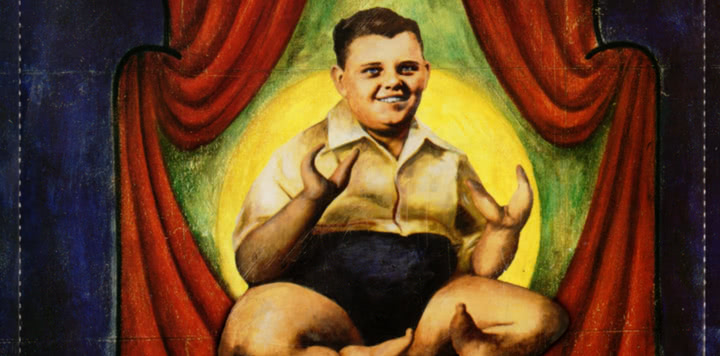Silverchair’s second album Freak Show turned 20 this week, which means the album is hitting that age where it begins to dismiss the riff-heavy, depressed tone of teenage albums such as itself.
Which is a real shame, because Freak Show was the album right before Daniel Johns’ ambition became alienating to swathes of his fan base, and also the most consistent in regards to blending Johns’ attempts to stretch out with the juvenile, guitar-focused moments from the first album. After Freak Show, every heavy song Silverchair included on an album seemed like a concession of sorts, wedged awkwardly between higher conceptual pieces in order to placate knuckle-dragging fans, American label heads who wanted another Frogstomp, and to operate as a bridge from old Silverchair to new Silverchair.
Freak Show is the only Silverchair album where relatively lovely songs like ‘Cemetery’ and ‘Abuse Me’ could bracket the punk blast of ‘Lie To Me’ and the dirge of ‘No Association’ without any element seeming forced. It’s got ‘The Door’ at track seven as a centrepiece, one of the most underrated Silverchair songs; with its Eastern raga-tinged riff, shifting structure, and singalong chorus, this song really should have graduated to Triple M high rotation status by now.
It is also one of those albums front-loaded with singles, and the more rockier songs, which means that months after you’d worn those down with repetition, but still want a blast of ‘Freak Show’, you begin to turn to the likes of ‘Petrol & Chlorine’ and ‘Roses’ for comfort – and possibly even trick yourself into believing ‘The Closing’ is the best song on the album (it’s not, it’s actually the tenth best). This is one of the best elements of a successful album: the way in which your favourite song shifts depending on how often you listen, what stage of your life you are in, and what mood you happen to be feeling on any given Tuesday.
Time to do some maths. Daniel Johns had just turned 17 when the band begun recording Freak Show, which would make him 16 throughout the writing of the record, assuming that none of these songs were holdovers from Frogstomp.
We know that some of the heavier songs had been performed live as early as January 1995. We also know a demo version of ‘Freak’ was used in the trailer for a terrible sci-fi film named Screamers in early ’95 (30% Rotten Tomatoes; lost $15M at the US box office). In January 1995, Johns was still a few months from turning 16, so we can safely assume all these songs were written by a 15- or 16-year-old kid.
This might sound like finicky fact-checking, but this knowledge is important to your enjoyment of this album for many, many reasons. For one, it’s impressive how well-structured and ambitious the songs are. Johns is a king at vocal melody, at vocal nuance, and at writing simple drop-D riffs that can stir a mosh pit into a sea of bouncing hair and oversized tees. The band are tight, and lock in with a instinct that only kids who learned how to play their instruments together do.
Most importantly, knowing their tender age forgives a litany of lyrical sins, recasting a lot of cloying lines as charming or cute. ”No more maybes, baby’s got rabies / Sitting on a ball in the middle of the Andes”. This is how the lead single from this album presents itself. Straight-faced, as the bluntest riff pounds the same two chords into submission. Imagine if Something For Kate tried to release such garble this month. They would be pounded into submission, and rightly so.
Let’s not forget the video for ‘Freak’ either, in which the band rock out in a science lab while their sweat is collected and fed to an old woman who begins to regain her youth, before turning into an alien creature for some unexplained, unimportant reason. Let’s not also forget this song featured on Daria, which is the perfect place for it.
‘Learn To Hate’ is a song you probably haven’t thought about or heard in years, so go give it a listen now – I can wait. It’s pretty good, hey? It’s sequenced as track nine, after Johns’ most unabashed pop song at this point, ‘Pop Song For Us Rejects’ (despite the ‘dark’ lyrical content, this song bounces like The Carpenters). I only mention this song because the chorus contains the line, “come and join the mass debate”, and there is simply no way to hear this without picturing three 16-year-olds giggling about adding a wanking joke into the chorus, deadly sure they had pulled this over on the unsuspecting adults.
There are also two separate cold sore references on this album. “Your life’s an open cold sore, got to get out the cream” from the aforementioned ‘Pop Song For Us Rejects’ and the classic ‘Freak’ line, “seems it’s in fashion to need the cold sore cream”. This says quite a lot.
Now, let’s talk about the song that opens the album, ‘Slave’. It’s a call to arms, and acted as sound assurance that this album would be as good as the first. It even outriffs the opener to Frogstomp, ‘Israel’s Son’, which we all must know and accept as containing two of the greatest riffs ever. Listen to ‘Slave’ again. Now imagine three teenagers, dressed in Helmet tees, cargo-looking pants, and swollen sneakers stepping onto a stage somewhere, anywhere, and kicking into this.
Now imagine young Daniel, hidden behind his flaxen hair, slowly shedding his baby fat, just tearing into these vocals. Imagine the double-time freak-out part towards the end leading back into the half-time riff. What were you doing when you were 17? It wasn’t this, I can almost assure you.
You can point at the maturity of ‘Cemetery’, draped in strings and sentiment, or the waltzing ‘Roses’, or even the “throw the sailors overboard” section in ‘Abuse Me’ if you want proof they were operating at a higher level this time around. But it’s only because of songs like the sneering, twisting ‘No Association’ that these lighter moments don’t become too cloying. Johns often tackles big subjects in a… well, teenage way, which is why a lot of these songs rang so true to so many, and it’s also why, two decades older, the same people whose lives may have been saved by certain lyrics now thank Christ they didn’t get those same sentiments tattooed on themselves. (It just occurred to me that many people could have Freak Show tats, so get in contact if you have “a crying wasteland, filled with shame” twisted around your torso in black cursive.)
Listening back, it’s apparent that you needed to be a certain age to love this album wholly, and that you probably needed to love this album wholly in order to now skim over the flaws, or at least regard them fondly. This is definitely an album rooted in a time and an age, which is a different thing to saying that it doesn’t hold up 20 years later.
It does hold up, but in a different, lighter way. It’s like seeing your high school sweetheart many decades later – you don’t feel the love, but you can remember how it felt. It’s how music works sometimes. But it’s enough that it works at all.



































